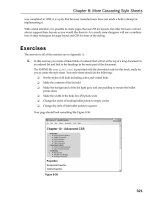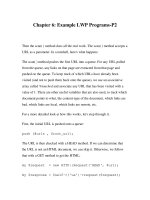Web Client Programming with Perl-Chapter 5: The LWP Library- P2
Bạn đang xem bản rút gọn của tài liệu. Xem và tải ngay bản đầy đủ của tài liệu tại đây (70.8 KB, 32 trang )
Chapter 5: The LWP Library- P2
HTTP::Response
Responses from a web server are described by HTTP::Response objects. If
LWP has problems fulfilling your request, it internally generates an
HTTP::Response object and fills in an appropriate response code. In the
context of web client programming, you'll usually get an HTTP::Response
object from LWP::UserAgent and LWP::RobotUA. If you plan to write
extensions to LWP or a web server or proxy server, you might use
HTTP::Response to generate your own responses.
$r = new HTTP::Response ($rc, [$msg, [$header, [$content]]])
In its simplest form, an HTTP::Response object can contain just a
response code. If you would like to specify a more detailed message
than "OK" or "Not found," you can specify a human-readable
description of the response code as the second parameter. As a third
parameter, you can pass a reference to an HTTP::Headers object to
specify the response headers. Finally, you can also include an entity-
body in the fourth parameter as a scalar.
$r->code([$code])
When invoked without any parameters, the code( ) method returns the
object's response code. When invoked with a status code as the first
parameter, code( ) defines the object's response to that value.
$r->is_info( )
Returns true when the response code is 100 through 199.
$r->is_success( )
Returns true when the response code is 200 through 299.
$r->is_redirect( )
Returns true when the response code is 300 through 399.
$r->is_error( )
Returns true when the response code is 400 through 599. When an
error occurs, you might want to use error_as_HTML( ) to generate an
HTML explanation of the error.
$r->message([$message])
Not to be confused with the entity-body of the response. This is the
human-readable text that a user would usually see in the first line of
an HTTP response from a server. With a response code of 200
(RC_OK), a common response would be a message of "OK" or
"Document follows." When invoked without any parameters, the
message( ) method returns the object's HTTP message. When invoked
with a scalar parameter as the first parameter, message( ) defines the
object's message to the scalar value.
$r->header($field [=> $val],...)
When called with just an HTTP header as a parameter, this method
returns the current value for the header. For example, $myobject-
>('content-type') would return the value for the object's Content-
type header. To define a new header value, invoke header( ) with an
associative array of header => value pairs, where value is a scalar or
reference to an array. For example, to define the Content-type header,
one would do this:
$r->header('content-type' => 'text/plain')
By the way, since HTTP::Response inherits HTTP::Message, and
HTTP::Message contains all the methods of HTTP::Headers, you can
use all the HTTP::Headers methods within an HTTP::Response
object. See "HTTP::Headers" later in this section.
$r->content([$content])
To get the entity-body of the request, call the content( ) method
without any parameters, and it will return the object's current entity-
body. To define the entity-body, invoke content( ) with a scalar as its
first parameter. This method, by the way, is inherited from
HTTP::Message.
$r->add_content($data)
Appends $data to the end of the object's current entity-body.
$r->error_as_HTML( )
When is_error( ) is true, this method returns an HTML explanation of
what happened. LWP usually returns a plain text explanation.
$r->base( )
Returns the base of the request. If the response was hypertext, any
links from the hypertext should be relative to the location specified by
this method. LWP looks for the BASE tag in HTML and Content-
base/Content-location HTTP headers for a base
specification. If a base was not explicitly defined by the server, LWP
uses the requesting URL as the base.
$r->as_string( )
This returns a text version of the response. Useful for debugging
purposes. For example,
use HTTP::Response;
use HTTP::Status;
$response = new HTTP::Response(RC_OK, 'all is
fine');
$response->header('content-length' => 2);
$response->header('content-type' =>
'text/plain');
$response->content('hi');
print $response->as_string( );
would look like this:
--- HTTP::Response=HASH(0xc8548) ---
RC: 200 (OK)
Message: all is fine
Content-Length: 2
Content-Type: text/plain
hi
-----------------------------------
$r->current_age
Returns the numbers of seconds since the response was generated by
the original server. This is the current_age value as described in
section 13.2.3 of the HTTP 1.1 spec 07 draft.
$r->freshness_lifetime
Returns the number of seconds until the response expires. If
expiration was not specified by the server, LWP will make an
informed guess based on the Last-modified header of the
response.
$r->is_fresh
Returns true if the response has not yet expired. Returns true when
(freshness_lifetime > current_age).
$r->fresh_until
Returns the time when the response expires. The time is based on the
number of seconds since January 1, 1970, UTC.
HTTP::Headers
This module deals with HTTP header definition and manipulation. You can
use these methods within HTTP::Request and HTTP::Response.
$h = new HTTP::Headers([$field => $val],...)
Defines a new HTTP::Headers object. You can pass in an optional
associative array of header => value pairs.
$h->header($field [=> $val],...)
When called with just an HTTP header as a parameter, this method
returns the current value for the header. For example, $myobject-
>('content-type') would return the value for the object's Content-type
header. To define a new header value, invoke header( ) with an
associative array of header => value pairs, where the value is a scalar
or reference to an array. For example, to define the Content-type
header, one would do this:
$h->header('content-type' => 'text/plain')
$h->push_header($field, $val)
Appends the second parameter to the header specified by the first
parameter. A subsequent call to header( ) would return an array. For
example:
$h->push_header(Accept => 'image/jpeg');
$h->remove_header($field,...)
Removes the header specified in the parameter(s) and the header's
associated value.
HTTP::Status
This module provides functions to determine the type of a response code. It
also exports a list of mnemonics that can be used by the programmer to refer
to a status code.
is_info( )
Returns true when the response code is 100 through 199.
is_success( )
Returns true when the response code is 200 through 299.
is_redirect( )
Returns true when the response code is 300 through 399.
is_client_error( )
Returns true when the response code is 400 through 499.
is_server_error( )
Returns true when the response code is 500 through 599.
is_error( )
Returns true when the response code is 400 through 599. When an
error occurs, you might want to use error_as_HTML( ) to generate an
HTML explanation of the error.
There are some mnemonics exported by this module. You can use them in
your programs. For example, you could do something like:
if ($rc = RC_OK) {....}
Here are the mnemonics:
RC_CONTINUE (100) RC_NOT_FOUND (404)
RC_SWITCHING_PROTOCOLS
(101)
RC_METHOD_NOT_ALLOWED
(405)
RC_OK (200) RC_NOT_ACCEPTABLE (406)
RC_CREATED (201)
RC_PROXY_AUTHENTICATION_
REQUIRED (407)
RC_ACCEPTED (202) RC_REQUEST_TIMEOUT (408)
RC_NON_AUTHORITATIVE_INF
ORMATION (203)
RC_CONFLICT (409)
RC_NO_CONTENT (204) RC_GONE (410)
RC_RESET_CONTENT (205) RC_LENGTH_REQUIRED (411)
RC_PARTIAL_CONTENT (206)
RC_PRECONDITION_FAILED
(412)
RC_MULTIPLE_CHOICES (300)
RC_REQUEST_ENTITY_TOO_LA
RGE (413)
RC_MOVED_PERMANENTLY
(301)
RC_REQUEST_URI_TOO_LARGE
(414)
RC_MOVED_TEMPORARILY
(302)
RC_UNSUPPORTED_MEDIA_TYP
E (415)
RC_SEE_OTHER (303)
RC_INTERNAL_SERVER_ERROR
(500)
RC_NOT_MODIFIED (304) RC_NOT_IMPLEMENTED (501)
RC_USE_PROXY (305) RC_BAD_GATEWAY (502)
RC_BAD_REQUEST (400)
RC_SERVICE_UNAVAILABLE
(503)
RC_UNAUTHORIZED (401) RC_GATEWAY_TIMEOUT (504)
RC_PAYMENT_REQUIRED (402)
RC_HTTP_VERSION_NOT_SUPP
ORTED (505)
RC_FORBIDDEN (403)
See the section "Server Response Codes" in Chapter 3 for more information.
HTTP::Date
The HTTP::Date module is useful when you want to process a date string.
time2str([$time])
Given the number of seconds since machine epoch,[3] this function
generates the equivalent time as specified in RFC 1123, which is the
recommended time format used in HTTP. When invoked with no
parameter, the current time is used.
str2time($str [, $zone])
Converts the time specified as a string in the first parameter into the
number of seconds since epoch. This function recognizes a wide
variety of formats, including RFC 1123 (standard HTTP), RFC 850,
ANSI C asctime( ), common log file format, UNIX "ls -l", and
Windows "dir", among others. When a time zone is not implicit in the
first parameter, this function will use an optional time zone specified
as the second parameter, such as "-0800" or "+0500" or "GMT". If the
second parameter is omitted and the time zone is ambiguous, the local
time zone is used.
The HTML Module
The HTML module provides an interface to parse HTML into an HTML
parse tree, traverse the tree, and convert HTML to other formats. There are
eleven classes in the HTML module, as shown in Figure 5-4.
Figure 5-4. Structure of the HTML module









